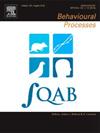自然颜色的变化影响招潮蟹(Leptuca leptodactyla)的配偶选择。
IF 1.3
4区 生物学
Q4 BEHAVIORAL SCIENCES
引用次数: 0
摘要
在一些物种中,可见光和紫外线(UV)反射率的自然变化与个体的生殖质量有关。然而,在评估紫外线信息的价值时,大多数研究采用完全阻挡紫外线反射的实验处理,因此忽略了自然颜色的个体差异。例如,我们已经知道雌性招潮蟹可能会拒绝那些爪子没有自然紫外线反射能力的雄性(例如,用防晒霜覆盖它们),但雄性招潮蟹爪子颜色的自然变化如何影响雌性的配偶选择仍然不清楚。在这里,我们研究了这个问题,并假设雌性招潮蟹可以使用雄性的自然颜色变化作为选择伴侣的参数。为了研究招潮蟹对雌性的偏好,我们在红树区内设置了一个实验场所,将雌性招潮蟹(n = 100)与同种雄性招潮蟹配对(n = 100)。在记录了雌性的选择后,我们用光谱仪量化了每只雄性的放大爪子的自然反射率(即颜色),并提取了它们的比色参数(即亮度、饱和度和色调)。我们的研究结果表明,雌性明显偏爱高亮度和低绿色饱和度的雄性。我们讨论了亮度和饱和度是被检测性状的冗余属性的可能性,它们都向雌性传递有关雄性个体质量的信息。本文章由计算机程序翻译,如有差异,请以英文原文为准。
Variation in natural color influences mate choice in a fiddler crab (Leptuca leptodactyla)
In several species, natural variation in visible and ultraviolet (UV) light reflectance has been linked to individual reproductive quality. However, when evaluating the value of UV information, most studies employ experimental treatments that completely block UV light reflection, therefore disregarding individual variation in natural coloration. For instance, we already know that female fiddler crabs might refuse males whose claws are devoid of natural UV light reflectance (i.e., by covering them with sunscreen), yet it is still unclear how the natural variation in male fiddler crab claw coloration affects female mate choice. Here, we examine this question and hypothesize that female fiddler crabs can use natural male color variation as a parameter for partner selection. To investigate the preference of female fiddler crabs we set up an experimental arena in a mangrove area and presented female Leptuca leptodactyla (n = 100) with pairs (n = 100) of conspecific males. After registering a female’s choice, we quantified the natural reflectance (i.e., color) from the enlarged claw of each male, by using a spectrometer, and extracted their colorimetric parameters (i.e., brightness, saturation and hue). Our results showed that females significantly favored males displaying higher brightness and lower green saturation. We discuss the possibility that brightness and saturation are redundant properties of the examined trait, both conveying information about male individual quality to females.
求助全文
通过发布文献求助,成功后即可免费获取论文全文。
去求助
来源期刊

Behavioural Processes
生物-动物学
CiteScore
2.70
自引率
7.70%
发文量
144
审稿时长
4-8 weeks
期刊介绍:
Behavioural Processes is dedicated to the publication of high-quality original research on animal behaviour from any theoretical perspective. It welcomes contributions that consider animal behaviour from behavioural analytic, cognitive, ethological, ecological and evolutionary points of view. This list is not intended to be exhaustive, and papers that integrate theory and methodology across disciplines are particularly welcome.
 求助内容:
求助内容: 应助结果提醒方式:
应助结果提醒方式:


